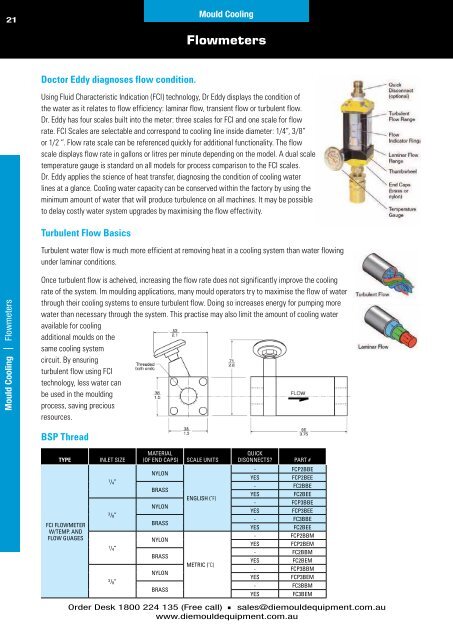Create successful ePaper yourself
Turn your PDF publications into a flip-book with our unique Google optimized e-Paper software.
21<br />
<strong>Mould</strong> Cooling | Flowmeters<br />
Doctor Eddy diagnoses flow condition.<br />
<strong>Mould</strong> Cooling<br />
Flowmeters<br />
using Fluid Characteristic Indication (FCI) technology, Dr Eddy displays the condition of<br />
the water as it relates to flow efficiency: laminar flow, transient flow or turbulent flow.<br />
Dr. Eddy has four scales built into the meter: three scales for FCI and one scale for flow<br />
rate. FCI Scales are selectable and correspond to cooling line inside diameter: 1/4”, 3/8”<br />
or 1/2 “. Flow rate scale can be referenced quickly for additional functionality. The flow<br />
scale displays flow rate in gallons or litres per minute depending on the model. A dual scale<br />
temperature gauge is standard on all models for process comparison to the FCI scales.<br />
Dr. Eddy applies the science of heat transfer, diagnosing the condition of cooling water<br />
lines at a glance. Cooling water capacity can be conserved within the factory by using the<br />
minimum amount of water that will produce turbulence on all machines. It may be possible<br />
to delay costly water system upgrades by maximising the flow effectivity.<br />
Turbulent Flow Basics<br />
Turbulent water flow is much more efficient at removing heat in a cooling system than water flowing<br />
under laminar conditions.<br />
Once turbulent flow is acheived, increasing the flow rate does not significantly improve the cooling<br />
rate of the system. Im moulding applications, many mould operators try to maximise the flow of water<br />
through their cooling systems to ensure turbulent flow. Doing so increases energy for pumping more<br />
water than necessary through the system. This practise may also limit the amount of cooling water<br />
available for cooling<br />
additional moulds on the<br />
same cooling system<br />
circuit. By ensuring<br />
turbulent flow using FCI<br />
technology, less water can<br />
be used in the moulding<br />
process, saving precious<br />
resources.<br />
BSP Thread<br />
TyPE inlet size<br />
fCi flowmeter<br />
w/temp. and<br />
flow guages<br />
1/4”<br />
3/8”<br />
1/4”<br />
3/8”<br />
material<br />
(of end Caps) sCale units<br />
nylon<br />
brass<br />
nylon<br />
brass<br />
nylon<br />
brass<br />
nylon<br />
brass<br />
english (˚F)<br />
metriC (˚C)<br />
quiCk<br />
disonneCts? part #<br />
- fCp2bbe<br />
yes fCp2bee<br />
- fC2bbe<br />
yes fC2bee<br />
- fCp3bbe<br />
yes fCp3bee<br />
- fC3bbe<br />
yes fC2bee<br />
- fCp2bbm<br />
yes fCp2bem<br />
- fC2bbm<br />
yes fC2bem<br />
- fCp3bbm<br />
yes fCp3bem<br />
- fC3bbm<br />
yes fC3bem<br />
Order Desk 1800 224 135 (Free call) n sales@diemouldequipment.com.au<br />
www.diemouldequipment.com.au


